Explore Nature’s Sanctuary: Best Chopta Tour Deals & Itineraries
Published on June 24, 2025
Chopta tour package, Tucked away in the Garhwal Himalayas of Uttarakhand, Chopta is a rare blend of serenity, spirituality, and adventure. With emerald meadows, snow-clad peaks, and sacred temples, it offers the perfect escape from urban chaos. Whether you’re a solo traveler, a couple seeking romance, or a group chasing thrilling treks, there’s a Chopta tour package tailored just for you.
Why Choose a Chopta Tour?
The beauty of a Chopta tour lies in its simplicity. Uncrowded trails, rich forests, and crisp mountain air make it a dream destination for those who crave peace and purpose. But beyond that, Chopta is also the gateway to two iconic Himalayan treks—the Chopta Tungnath trek and the Chopta Chandrashila trek.
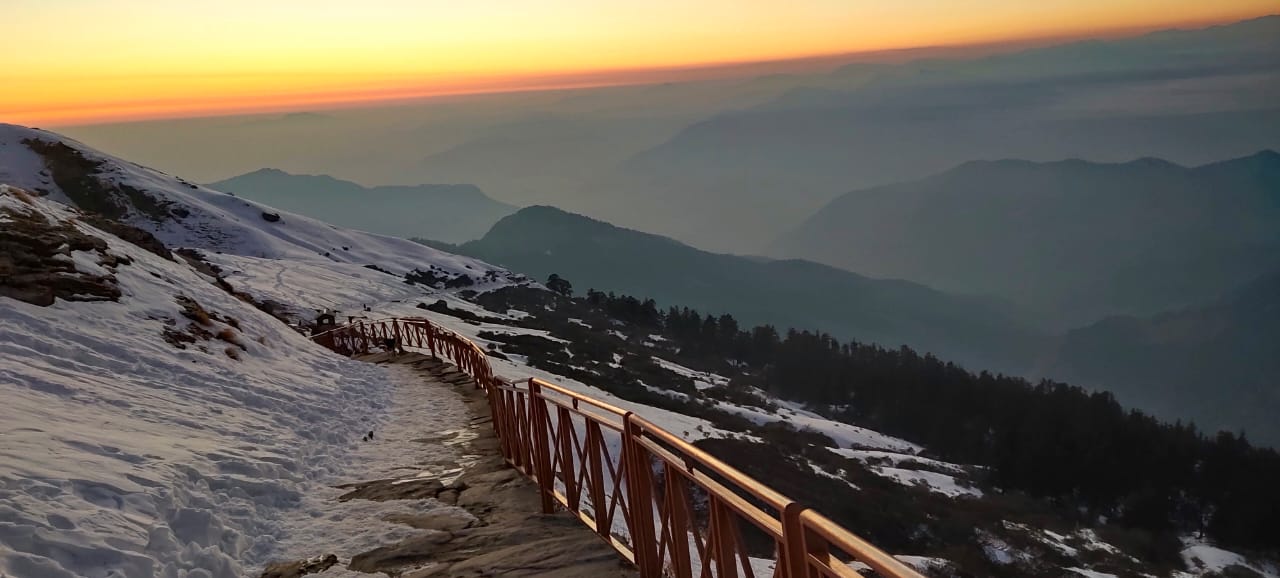
Step-by-Step to Serenity: Chopta Trek & Travel Itinerary
Day 0: Departure from Delhi – Overnight Journey
10:00 PM: Depart from Delhi by AC Volvo bus or shared cab or tempo traveller towards Chopta.
Overnight: Onboard journey to Sari Village (approx. 12–14 hours).
Day 1: Arrival at Sari Village – Deoria Tal Trek & Bonfire Night
Morning: Reach Sari Village , check-in at cottages.
Afternoon: Begin trek to Deoria Tal (3 km, approx. 1.5 hrs one-way).
Enjoy scenic views of Himalayan peaks reflected in the crystal-clear lake.
Evening: Return to cottages, relax, and enjoy a bonfire & DJ night under the stars.
Stay: Overnight in cottages at Sari Village.
Day 2: Chopta – Tungnath Temple Trek to Chandrashila Summit
Early Morning: Drive to Chopta (approx. 1 hour).
Trek: Start the Tungnath Temple trek (3.5 km, 2–3 hours).
Visit Tungnath Temple (highest Shiva temple), then ascend to Chandrashila Peak (1 km further).
Breathtaking 360° views of Nanda Devi, Trishul, Kedar Dome, and more.
Afternoon: Return to Chopta for lunch.
Evening: Free time to explore local cafes or nature trails.
Stay: Overnight in cottages at Chopta.
Day 3: Explore Ukhimath & Dhari Devi – Return to Delhi
Morning: Visit Ukhimath (winter seat of Lord Kedarnath) and Dhari Devi Temple (on Alaknanda River).
Afternoon: Depart for Delhi via Devprayag.
Evening/Night: Stop for dinner en route.
Arrival: Reach Delhi by late night.

Inclusions
-
Transportation (Delhi/Haridwar/Rishikesh to Chopta & return – by tempo traveler or car)
-
Accommodation (Camps or guesthouses on twin/triple sharing)
-
Meals (Breakfast & Dinner – veg)
-
Trekking Guide for Tungnath Temple trek and Chandrashila summit trek
-
Trek Permits & Forest Entry Fees
-
Bonfire (weather permitting)
-
Basic First Aid Kit
-
Tour Captain / Trip Leader support
-
Group Photos & Assistance for Memories
Exclusions
-
Lunch during travel or trekking days
-
Personal expenses (snacks, drinks, shopping, etc.)
-
Any travel insurance or emergency evacuation charges
-
Tips to guide/driver or hotel staff
-
Porter or mule for personal luggage
-
Additional sightseeing or activities not mentioned in itinerary
-
Entry fees to temples or attractions (if any)
-
GST / Government taxes (if applicable)
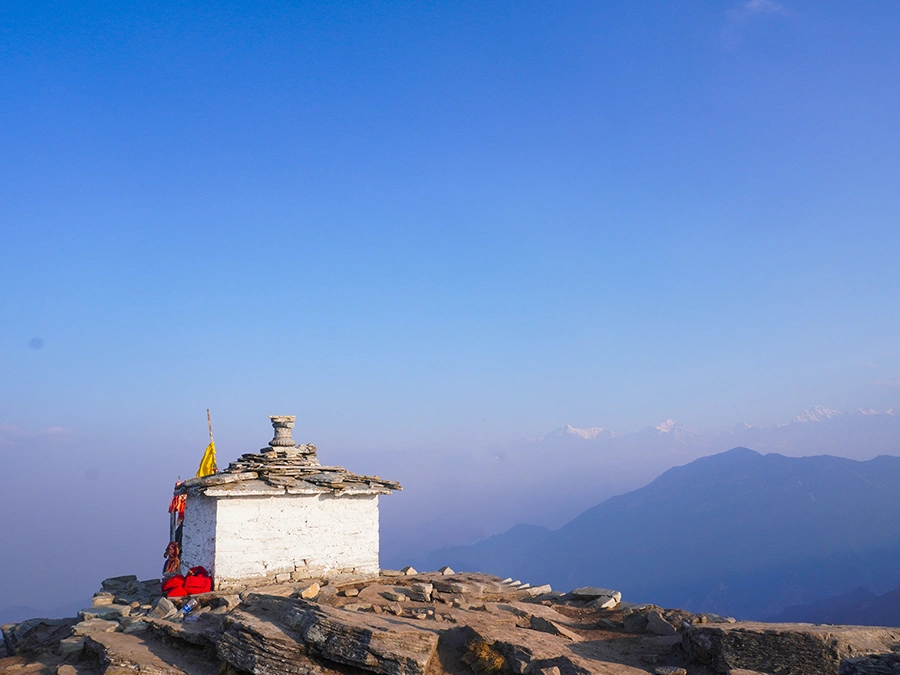
What to Pack & What to Skip for Your Chopta Tour
Heading to Chopta means preparing for serene treks, chilly nights, and nature at its raw best. Smart packing helps you stay light, warm, and ready for anything—from the Chopta Tungnath trek to the Chandrashila summit trek.
What to Pack for Chopta
Clothing Essentials
-
Thermal Inners (Top & Bottom)
-
Fleece Jacket / Down Jacket
-
Quick-dry T-shirts & Trekking Pants
-
Woolen Cap, Muffler & Gloves
-
Windcheater / Rain Jacket
-
Extra Socks & Undergarments
Footwear
-
Trekking Shoes with ankle support and grip
-
Flip-Flops (for camps/stay)
Gear & Accessories
-
Backpack (30–50L) with rain cover
-
Water Bottle / Hydration Pack
-
Sunglasses & Sunscreen (SPF 30+)
-
Lip Balm & Moisturizer (dry weather)
-
Headlamp / Torch with extra batteries
-
Personal First Aid Kit
-
Power Bank / Charging Cables
Documents & Personal Items
-
Valid ID Proof (Aadhaar/Driving License)
-
Basic Toiletries (toothbrush, soap, towel)
-
Cash in small denominations (limited ATM access)
What to Skip
-
Heavy Denim or Bulky Clothes – Not suitable for trekking
-
Hair Dryers & Makeup Kits – No need in camps or remote stays
-
Jewelry & Valuables – Risk of loss, not needed
-
Laptops/Tablets – No use, limited connectivity
-
Plastic Bottles / Disposables – Use eco-friendly gear
-
Loud Bluetooth Speakers – Disturbs the serene natural environment
-
Excess Luggage – Stay light and mobile for trekking ease

Seasons of Serenity: Understanding the Weather in Chopta
Chopta isn’t just a destination—it’s an experience shaped beautifully by the seasons. Nestled at around 2,600 meters in Uttarakhand’s Garhwal Himalayas, Chopta offers a dramatic play of weather throughout the year. Whether you’re chasing snow-capped trails or meadows drenched in golden light, Chopta’s weather transforms every journey into something magical.
Summer (May to June): Clear, Cool, and Comfortable
-
Temperature: 10°C to 22°C
-
Vibe: Lush green trails, cool breezes, ideal for day treks
-
Perfect For: Families and first-time trekkers enjoying the Chandrashila summit trek
Monsoon (July to September): Misty Trails & Moody Skies
-
Temperature: 8°C to 18°C
-
Vibe: Verdant landscapes, light to heavy rains, cloud-kissed peaks
-
Note: Treks may be slippery; check trail conditions before planning
Autumn (October to November): Crisp Air & Clear Views
-
Temperature: 5°C to 14°C
-
Vibe: Golden forests, clear skies, great mountain visibility
-
Perfect For: Trekking to Tungnath temple and camping under starry skies
Winter (December to February): Snowy Silence
-
Temperature: -5°C to 10°C
-
Vibe: Snow-covered meadows, frozen trails, serene solitude
-
Perfect For: Snow lovers and thrill-seekers on the Chopta Chandrashila trek from Delhi
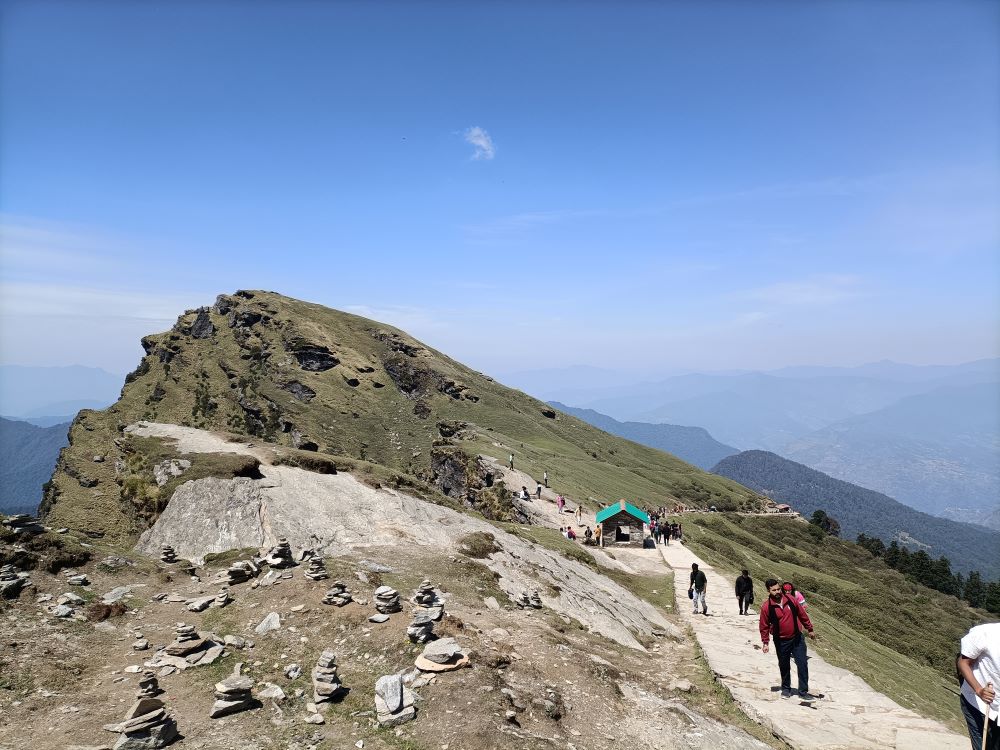
Stay Amidst Serenity: Accommodations in Chopta
When it comes to experiencing the Himalayas up close, Chopta offers more than just majestic views—it offers a stay in nature’s lap. Whether you’re looking for comfort, adventure, or budget stays, Chopta’s accommodation options blend rustic charm with Himalayan tranquility.
Types of Accommodations in Chopta
1️⃣ Campsites – Sleep Under the Stars
For those who want to be one with nature, camping in Chopta is the most immersive experience. From alpine tents to luxury Swiss camps, the views of snow-capped peaks and crisp mountain air make it unforgettable.
-
Includes: Sleeping bags, insulated bedding, bonfire (weather-permitting), meals
-
Popular Spots: Duggalbitta, Baniyakund, Chopta Meadows
-
Great for: Adventurers, trekkers, photographers, and group tours
2️⃣ Eco-Stays & Cottages – Rustic Meets Comfort
Scattered around Chopta and nearby villages like Sari and Baniyakund, these quaint wooden cottages and eco-huts offer privacy and warmth.
-
Includes: Cozy rooms, attached bathrooms, hot water, local cuisine
-
Views: Lush meadows, rhododendron forests, and distant Himalayan ranges
-
Ideal for: Couples, families, and nature lovers
3️⃣ Guesthouses – Budget-Friendly & Cozy
For budget travelers, simple guesthouses are available with basic amenities and homely vibes. Clean, safe, and managed by locals who’ll treat you like family.
-
Includes: Neat rooms, warm food, essential comforts
-
Great for: Solo travelers, students, weekend trips

What to Expect
-
Limited luxury but abundant tranquility
-
Basic electricity (solar in some places)
-
Wi-Fi is rare – but mobile networks like Jio and BSNL work in spots
-
Evenings are magical – starry skies, warm bonfires, and mountain silence
Where to Stay Based on Your Trek Plan:
-
Near Sari Village: Great if you plan to explore Deoria Tal
-
Baniyakund or Duggalbitta: Closer to the Tungnath temple trek start point
-
Meadows of Chopta: For direct access to treks and camping in high-altitude bliss
Wild & Wonderful: Exploring the Flora and Fauna of Chopta
Cradled within the Kedarnath Wildlife Sanctuary, Chopta is more than just a trekking paradise—it’s a vibrant natural habitat teeming with Himalayan flora and fauna. Whether you're walking the sacred Chopta Tungnath trek or gazing from the Chandrashila summit, the biodiversity here surrounds you in every leaf rustle and birdcall.
Flora of Chopta – Nature’s Garden at Altitude
Chopta’s forests and meadows are a spectacle of seasonal color and Himalayan resilience. From lush summer greenery to snow-dusted pines in winter, each season brings a different shade of beauty.
Dominant Tree Species:
-
Rhododendron: In full bloom during spring, painting forests red and pink.
-
Deodar & Oak Trees: Evergreen giants offering cool shade and rich green tones.
-
Maple & Birch: Their autumn hues turn Chopta into a golden wonderland.
Wildflowers & Herbs:
-
Primulas, Anemones, and Aconites: Covering meadows like a floral carpet.
-
Medicinal Herbs: Including rare alpine species like Yarsagumba and Brahma Kamal in higher altitudes.

Fauna of Chopta – The Wild Calls Softly
As part of the Kedarnath Wildlife Sanctuary, Chopta is home to some elusive and enchanting Himalayan wildlife. The silent forests and rugged hills create the perfect environment for rare species to thrive.
Commonly Spotted Mammals:
-
Himalayan Musk Deer: A shy, rare species often seen in the early morning.
-
Barking Deer & Goral: Agile and alert, found near forest edges.
-
Himalayan Fox & Weasel: Small but quick—usually spotted at dusk.
-
Leopard & Black Bear: Reside in deeper sanctuary areas, rarely seen by casual trekkers.
Birdlife Paradise:
-
Himalayan Monal: The vibrant state bird of Uttarakhand, often seen along trails.
-
Cheer & Koklass Pheasants: Thrive in the meadows and underbrush.
-
Snow Partridge & Griffon Vulture: Spotted higher up on the Chandrashila summit trek.
-
Woodpeckers, Thrushes, and Tits: Common among bird watchers.
Best Places to Spot Flora & Fauna:
-
Chopta–Tungnath trail
-
Chandrashila summit ridge
-
Deoriatal trek via Sari Village
-
Baniyakund and Duggalbitta meadows
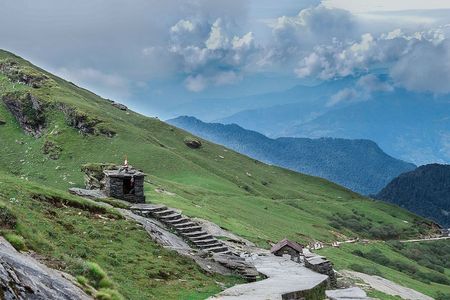
Chopta Through Time: A Sacred Past in the Heart of the Himalayas
Far beyond its tranquil meadows and snowy peaks, Chopta carries a deep spiritual and cultural legacy rooted in Himalayan mythology and regional tradition. Often called the “Mini Kedarnath Gateway”, this serene village nestled in Uttarakhand’s Rudraprayag district is more than a scenic destination—it’s a historical gem silently echoing centuries of devotion and natural preservation.
Mythological Origins: Legends from the Mahabharata
Chopta holds significant mythological relevance as the starting point for the trek to Tungnath, the highest Shiva temple in the world. According to the Mahabharata, the Pandavas came to this region seeking penance for their sins after the Kurukshetra war. Lord Shiva, displeased with the bloodshed, disguised himself and fled, eventually taking the form of a bull and diving underground at Kedarnath.
It’s believed that his arms emerged at Tungnath, making it one of the sacred Panch Kedar temples. This divine legend makes Chopta a spiritual pathway for pilgrims and seekers alike.
Historical Evolution: From Pastures to Pilgrimage Path
Traditionally, Chopta was used by local shepherds as a seasonal pasture. The region remained isolated for centuries, its rugged terrains and snowy winters limiting outside influence. However, over time, as more pilgrims and trekkers began exploring the Tungnath temple trek and Chandrashila summit, the area gained attention for its untouched natural beauty.
In recent decades, it has evolved from a hidden meadow to a sought-after trekking and eco-tourism destination, drawing both spiritual travelers and adventure enthusiasts.
Preservation Through Sanctuary: A Natural Legacy
With the creation of the Kedarnath Wildlife Sanctuary, Chopta became a protected region—ensuring the preservation of its rich flora, fauna, and biodiversity. This protection not only honors its natural legacy but also preserves the cultural sanctity of this Himalayan haven.
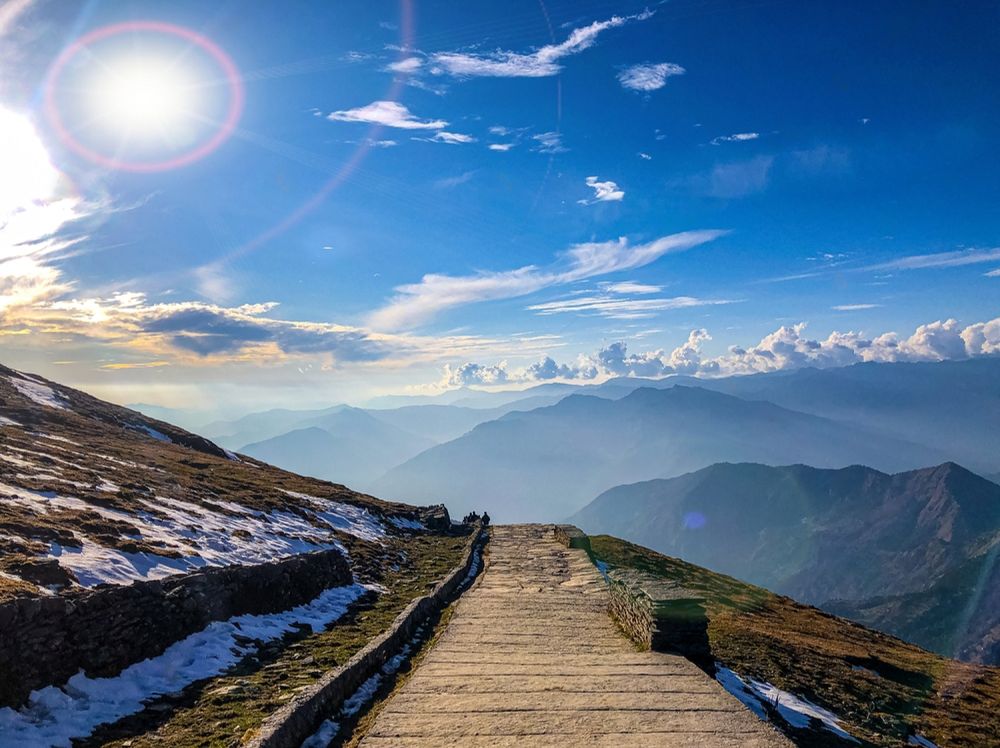
Today: Where History Meets Harmony
Today, Chopta stands at the intersection of mythology, natural heritage, and modern exploration. Whether you're walking ancient pilgrimage paths or trekking scenic trails, every step through Chopta is a walk through timeless silence and sacred echoes.
Experience this living history with a curated Chopta tour package from TourMyHoliday—where every journey becomes a soulful chapter in your own story.
Frequently Asked Questions:
1. What is Chopta famous for?
Chopta is known for the Tungnath Temple trek, Chandrashila summit, scenic meadows, and rich biodiversity.
2. What is the historical significance of Chopta?
Chopta is the base for Tungnath, part of the Panch Kedar, linked to the Pandavas’ legends from the Mahabharata.
3. When is the best time to visit Chopta?
March to June for pleasant treks and flowers; December to February for snow and winter adventures.
4. How is the weather in Chopta?
Cool and pleasant in summer, misty in monsoon, and snowy in winter. Temperatures can drop below -5°C in winter.
5. What are the top treks in Chopta?
The Chopta Tungnath trek and Chandrashila summit trek are the most popular routes for beginners and trekkers.
6. What type of accommodation is available in Chopta?
Chopta offers tents, eco-cottages, and guesthouses—ranging from basic to semi-premium stays.
7. What wildlife can I spot in Chopta?
Chopta is home to Himalayan Monal, musk deer, foxes, pheasants, and alpine plant species like rhododendron.
8. Is Chopta suitable for couples or solo travelers?
Yes! Many packages are designed for couples, solo travelers, and groups with different comfort levels.
9. What should I pack for a Chopta trip?
Pack warm clothes, trekking shoes, torch, rain gear, personal medicine, and ID proof. Avoid overpacking and heavy electronics.
10. How to reach Chopta from Delhi or Haridwar?
You can book a Chopta tour package from Delhi or Haridwar via car, bus, or tempo traveler. Roads connect well up to the base.
.heic)


